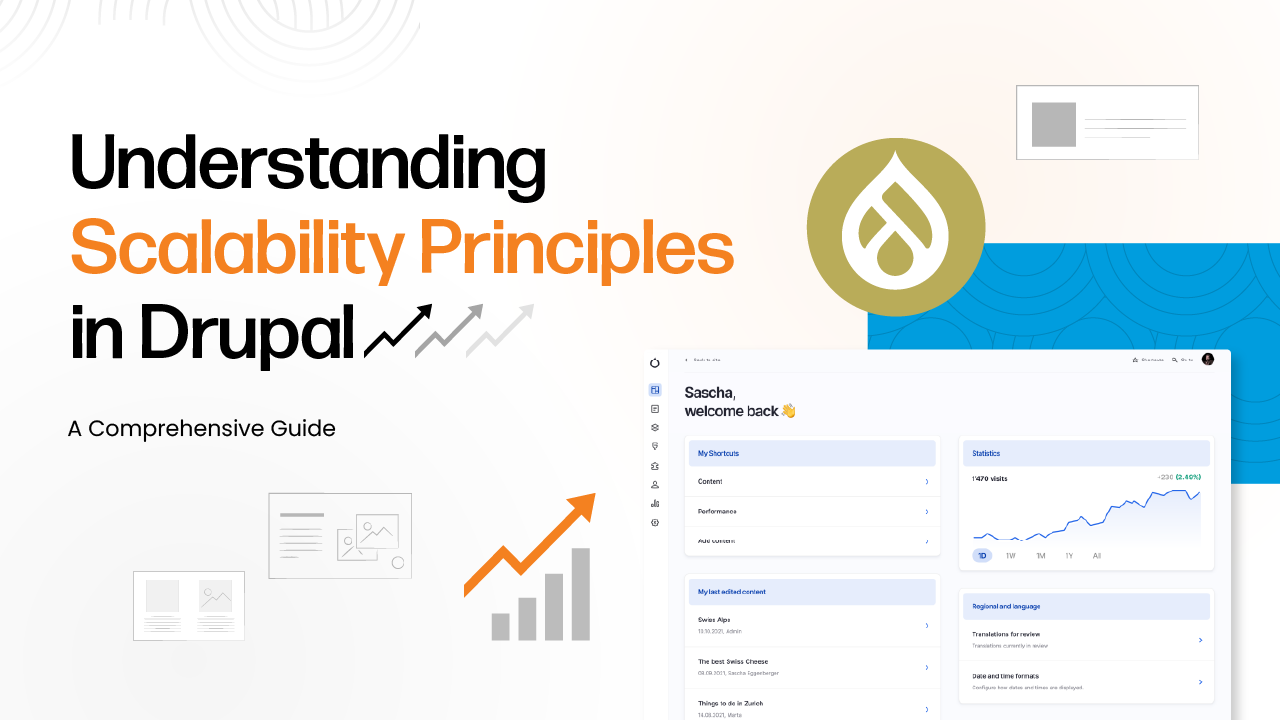May 13, 2024

Scalability is an important concern when creating websites or web applications with Drupal, a robust and versatile content management system (CMS). It refers to a system's ability to manage increasing amounts of work or its capacity to expand or accommodate that increase. In this comprehensive study, we'll look at Drupal's fundamental scalability principles, including performance optimisation, caching methods, and scaling tools.
Drupal development provides several critical tools and methods that help web projects scale efficiently, ensuring they can handle growing traffic, content volume, and user interactions.
Here's a detailed overview of scalability strategies in Drupal:
Drupal also allows interaction with external caching systems such as Varnish and Memcached, which improves scalability by offloading caching operations to dedicated servers.
Implementing a Content Delivery Network (CDN) in Drupal is critical for increasing website performance and scalability. By distributing static assets such as photos, CSS, and JavaScript files across a global network of servers, CDNs reduce server load and latency by providing content from servers closer to the user's geographic location. Drupal interacts perfectly with CDNs, allowing for easy administration and management of CDN settings right from the CMS interface. Administrators can easily define which content to send via the CDN and use caching options to boost speed further.
The database is essential to a Drupal site's functionality, so optimising its efficiency is critical for scalability. This optimisation comprises examining and optimising database queries to ensure quick execution and increased overall efficiency. Proper indexing of database tables is critical, especially for frequently requested data, because it considerably improves query efficiency. Drupal can improve site responsiveness by deliberately adding indexes that allow it to fetch important information quickly. Furthermore, database replication improves scalability by dividing read-intensive workloads across numerous replicas.
Effective content structuring and organisation are critical for Drupal's scalability. Designing simplified content types and fields reduces database bloat while optimising content retrieval. Drupal sites can maintain efficiency as content volume increases by carefully developing content types customised to specific purposes and removing extraneous fields. Taxonomy optimisation is equally important. Taxonomy vocabularies and keywords effectively categorise and organise content, allowing for straightforward navigation and extensive search functionality. Drupal sites that use a well-thought-out taxonomy structure can improve user experience and scalability by making it easier for users to find relevant information amidst rising volumes of data.
Load balancing is critical for Drupal scalability, as it distributes incoming web traffic across different servers to avoid overload. Drupal sites boost scalability and availability by deploying numerous web servers behind a load balancer. This configuration improves performance by intelligently spreading incoming requests, maximising resource utilisation, and reducing the possibility of server downtime or performance deterioration. It allows Drupal websites to smoothly accept increasing traffic volumes while still providing responsive and dependable user experiences.
Scaling horizontally entails adding more servers to the infrastructure to manage growing loads. With Drupal, horizontal scaling can be accomplished by:
Continuous performance monitoring is crucial for Drupal sites, facilitated by tools like New Relic, providing insights into application performance and resource utilisation. The Devel Module offers debugging and profiling tools to optimise Drupal code and database queries effectively. Additionally, performance profiling with tools like XHProf or Blackfire.io enables the identification of performance bottlenecks, empowering administrators to fine-tune site performance and ensure optimal scalability. These monitoring and profiling tools are essential components of Drupal's ecosystem, enabling proactive performance management and enhancing overall site efficiency and scalability.
TOptimising Drupal content delivery includes a variety of approaches for improving page load times and user experience. Lazy loading asynchronously loads pictures, scripts, and assets, putting more material above the fold and boosting perceived speed. CSS and JavaScript file sizes are reduced by minification and compression, which improves load speeds by reducing network transfers. Enabling gzip compression further reduces file sizes, resulting in speedier delivery. Furthermore, content aggregation consolidates CSS and JavaScript files, lowering the amount of HTTP requests and increasing performance. Drupal sites can leverage these approaches to efficiently provide content, resulting in faster page loads and increased user satisfaction.
Scalability is an important feature of Drupal website construction, particularly in today's digital landscape, when websites must handle increasing traffic and content volumes. Drupal websites can withstand increasing traffic while maintaining ideal performance and user experience by combining caching techniques, optimisation strategies, infrastructure design, and performance monitoring.
Drupal necessitates a comprehensive approach, from exploiting caching methods to maximise resource use and reduce server load to developing a scalable architecture capable of dynamically adjusting resources in response to demand. Continuous performance monitoring ensures that scalability issues are recognised and resolved early on, allowing Drupal sites to scale easily as they grow.
Dotsquares specialises in delivering proficient Drupal development solutions by employing the most effective Drupal scalability strategies. Their expertise ensures seamless scalability, catering to evolving business needs without compromising performance. Through meticulous planning and implementation, Dotsquares crafts robust Drupal solutions that empower you to achieve sustained success in the digital landscape.